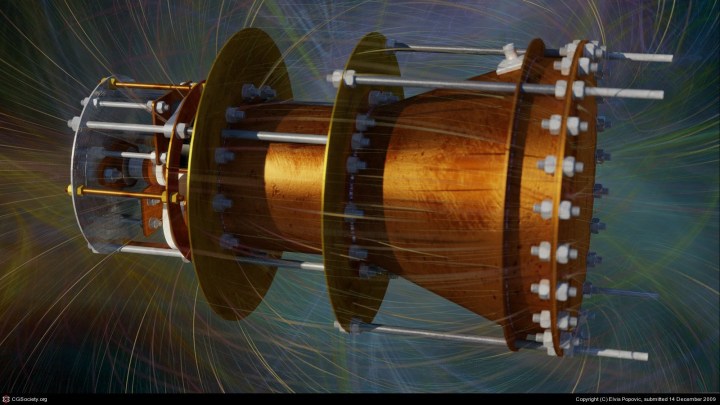
Last week, NASA’s peer-reviewed EM Drive paper was published under the title, “Measurement of Impulsive Thrust from a Closed Radio-Frequency Cavity in Vacuum” as an open-access “article in advance” in the American Institute of Aeronautics and Astronautics (AIAA)’s Journal of Propulsion and Power. It’s a monumental achievement for NASA, which has been grappling with the concept of the propulsion system since it was first proposed back in 1999 by British inventor Roger Shawyer.
In theory, the EM Drive doesn’t use rocket fuel, but rather sends microwaves back and forth within a conical metal cavity in order to produce thrust. As per Shawyer’s original estimates, the unprecedented efficiency of the EM Drive could send a rocket to Mars in only 10 weeks. Sound too good to be true? According to physics as it is understood today, it is. That’s because the EM Drive doesn’t adhere to Newton’s third law, which dictates that all action has an equal and opposite reaction. The EM Drive, however, seems to produce thrust without pushing anything else back.
The folks at NASA decided to put an actual EM Drive to the test, and the results of their experimentation comprise the contents of the newly published paper.
Most important is the finding that the drive does actually produce thrust in a vacuum, in this case, 1.2 millinewtons per kilowatt of thrust. Sure, that’s considerably less than the 60 millinewtons per kilowatt produced by the extremely powerful Hall thruster, but it’s important to note that the Hall thruster needs propellants to work, which means that the extra weight it carries might negate the higher thrust.
But really, the NASA team notes, no comparisons should be made at this point, because they weren’t at all aiming for peak performance in their tests. Rather, they were simply trying to determine whether or not the EM Drive really even works. And with the publication of the new paper, the EM Drive no longer seems to be the stuff of science fiction, but perhaps, of real science.
So what’s next for the EM Drive? In the coming months, it looks like it’s headed to space, and if it works there, then we’ll really be talking. You can check out the full results from the paper here.

